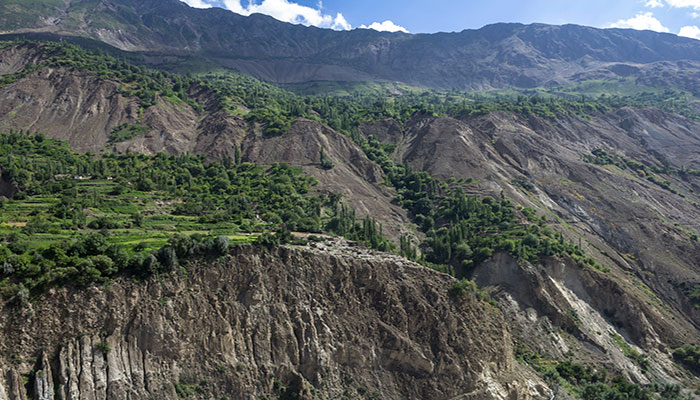To reduce impact of climate change, water scarcity: Nature-based techniques being adopted in GB
ISLAMABAD: The Ministry of Climate Change with the help of locals in Gilgit-Baltistan have adopted indigenous techniques in the form of ice-stupas, glacier grafting and avalanche harvesting as an excellent examples of nature-based solutions, demonstrating the best practices for reducing the climate change impacts and associated risks like water scarcity.
The concept is part of the Glacier Lake Outburst Flood (GLOF-ll) risk reduction project in the northern areas of Pakistan started in 2017 by the Ministry of Climate Change funded by the UNDP and the government of Gilgit-Baltistan with the total budget of 6.6 billion rupees.
As part of the GLOF-II project, the University of Baltistan compiled the first case study on glacier grafting and ice stupas. This case study report covers basic information along with most of the ethnographic accounts of the traditional indigenous technology of glacier grafting, farming and rearing. Preliminary scientific aspects were also discussed; however, deeper technical analysis of the process and technology is yet to be recorded and presented.
The Vice Chancellor of University of Gilgit-Baltistan, Prof. Dr Muhammad Naeem Khan told The News that glacier grafting is a long-term sustainable solution to meet water needs, improve local environment and climate at micro level in terms of increased vegetation, biodiversity, beautification of nature, reduced temperature for a longer period of the year and reduced rate of melting natural glaciers in the vicinity.
“Hence, we can say that the grafted glaciers are long-term solutions to the impacts of climate change at micro level and if multiplied, the effect could be seen at the regional level, contributing to the global climate change phenomena,” Dr Naeem said.
He said the ice stupas is an offshoot of the glacier grafting technique that harnesses underground water to create artificial glaciers in the form of conical-shaped ice heaps. To prevent the wastage of huge volume of water in the streams and rivers in winters, these stupas act as water reservoirs to fulfill the drinking and cultivation requirements of the locals, he added.
The third indigenous practice and technology told by Dr Naeem is avalanche harvesting by stopping avalanches well above in the mountain, that can then become good sources of water in early spring. The University of Baltistan has suggested avalanche harvesting as one of the risk reduction and water resource enhancement strategies planned to be experimented during 2022, Dr Naeem said.
Explaining the concept of ice stupas, Dr Naeem said that ice-stupas development is a short-term strategy to meet the need of water, particularly for the early spring irrigation. The officials of the ministry, when contacted by The News, said that amid the climate change crisis, the nature-based solutions, such as ice stupas ensure evidence-based and transformative changes to build the climate resilience of these mountain ecosystems. With funding from the Green Climate Fund and the support of the Ministry of Climate Change and the UNDP, the GLOF-II project aims to promote such indigenous-based practices and help reduce the risks and vulnerabilities from the glacial lake outburst floods in the northern areas of Pakistan, they added.
These activities are currently being performed in Gilgit-Baltistan, which receives an annual rainfall of less than 50 millimeters. Gilgit-Baltistan relies exclusively on water originating from snow and glacial melt and survives on small-scale agriculture and livestock rearing.
-
 Idris Elba Gets Honest About Managing Real-life Hijack Situation
Idris Elba Gets Honest About Managing Real-life Hijack Situation -
 Royal Family Buries King Charles' Cousin
Royal Family Buries King Charles' Cousin -
 Elizabeth Hurley Faces An Impossible Choice As Son Damian, Beau Billy Ray Cyrus Clash
Elizabeth Hurley Faces An Impossible Choice As Son Damian, Beau Billy Ray Cyrus Clash -
 Rare Pokémon Cards Worth $100k Stolen In New York Shop Robbery
Rare Pokémon Cards Worth $100k Stolen In New York Shop Robbery -
 Chevy Chase Shares Disappointment After 'SNL50: The Anniversary Special' Snub
Chevy Chase Shares Disappointment After 'SNL50: The Anniversary Special' Snub -
 Samuel L. Jackson's Old Movie Found New Life: Here's How
Samuel L. Jackson's Old Movie Found New Life: Here's How -
 Nobel Prize Snub Hardens Donald Trump's Tone On ‘peace’
Nobel Prize Snub Hardens Donald Trump's Tone On ‘peace’ -
 What's Prince Harry's Case Against The Daily Mail's Publisher?
What's Prince Harry's Case Against The Daily Mail's Publisher? -
 'Matilda' Star Mara Wilson Breaks Silence On AI's 'deepfake Apocalypse' After Being Abused
'Matilda' Star Mara Wilson Breaks Silence On AI's 'deepfake Apocalypse' After Being Abused -
 Meghan Markle 'ruined' Prince Harry's Life?
Meghan Markle 'ruined' Prince Harry's Life? -
 Super Bowl Halftime Show Gets Another Attraction Besides Bad Bunny
Super Bowl Halftime Show Gets Another Attraction Besides Bad Bunny -
 Princess Irene's Coffin Arrives For Funeral Rites
Princess Irene's Coffin Arrives For Funeral Rites -
 Sean Penn's Gay Role Interview Resurfaces After LA Stroll With Valeria Nicov
Sean Penn's Gay Role Interview Resurfaces After LA Stroll With Valeria Nicov -
 FBI’s Most Wanted Caught After 10 Years In Mexico
FBI’s Most Wanted Caught After 10 Years In Mexico -
 Inside Kate Middleton's Meaningful Nod To Own Milestone
Inside Kate Middleton's Meaningful Nod To Own Milestone -
 Zachary Levi 'running' To Build His Future In Politics?
Zachary Levi 'running' To Build His Future In Politics?




